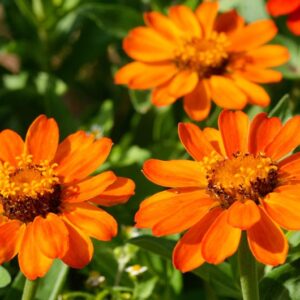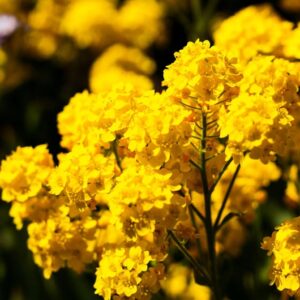
Exploring the world of flowers can often reveal hidden treasures and unexpected delights. In this article, we embark on a journey to discover the captivating realm of 23 flowers that start with X. While the selection may be rare and unique, these exquisite blooms possess an enchanting beauty that deserves our attention.
From delicate petals to striking forms, let us uncover the wonders of these extraordinary flowering plants that defy expectations and showcase nature’s creativity.
1. Xeranthemum (Xeranthemum annuum)

Image source: Pinterest
Xeranthemum, also known as immortelle, showcases papery flowers that come in various shades of purple, pink, and white. These blooms retain their color even after drying, making them excellent choices for everlasting flower arrangements or as ornamental additions to borders and cutting gardens.
2. Xerophyllum (Xerophyllum tenax)

Image source: Pinterest
Xerophyllum, commonly referred to as bear grass, features long, slender leaves and delicate clusters of white flowers. This perennial plant is native to North America and thrives in dry, mountainous regions. Its graceful presence and resilient nature make it a symbol of wild beauty and an ideal choice for naturalistic landscapes.
3. Xanthoceras (Xanthoceras sorbifolium)

Image source: Pinterest
Xanthoceras, also known as yellowhorn, boasts clusters of showy white flowers with yellow centers. This deciduous shrub is native to China and produces edible seeds. With its ornamental value and environmental adaptability, xanthoceras is a remarkable addition to gardens and urban landscapes, offering both aesthetic appeal and potential culinary uses.
4. Xylobium (Xylobium spp.)

Image source: Pinterest
Xylobium is a genus of orchids that encompasses various species with unique and intricate flowers. These orchids exhibit a wide range of colors, including vibrant yellows, oranges, and purples. With their exotic allure and intricate patterns, xylobium orchids are highly sought after by collectors and enthusiasts, bringing a touch of tropical elegance to indoor gardens and orchid enthusiasts’ collections.
5. Xanthosoma (Xanthosoma spp.)

Image source: Pinterest
Xanthosoma, also known as elephant ear, is a tropical plant with large, heart-shaped leaves and unique inflorescences. While the flowers may be small and inconspicuous, it is the impressive foliage that steals the show, adding a bold and tropical touch to gardens and landscapes.
6. Xerochrysum (Xerochrysum bracteatum)

Image source: Pinterest
Xerochrysum, commonly called strawflower or everlasting daisy, features vibrant, papery flowers in shades of yellow, orange, pink, and white. These resilient blooms retain their color even after drying, making them popular for floral crafts, wreaths, and everlasting flower arrangements.
7. Xeronema (Xeronema callistemon)

Image source: Pinterest
Xeronema, also known as poor knights lily, is a unique plant native to New Zealand. It showcases sword-like leaves and clusters of bright red, brush-like flowers. Xeronema is an endangered species and a true botanical treasure, making it a prized addition to collectors’ gardens and conservation efforts.
8. Xyris (Xyris spp.)

Image source: Pinterest
Xyris is a genus of plants commonly called yellow-eyed grass due to their distinctive yellow flowers with dark centers. These perennial plants are native to wetlands and marshy areas, adding a splash of color and texture to water gardens and naturalized landscapes.
9. Xiphidium (Xiphidium caeruleum)

Image source: Pinterest
Xiphidium, also known as blue sword lily, is a tropical plant that bears striking blue flowers resembling swords. This stunning flowering plant thrives in moist, shady conditions and is often cultivated for its eye-catching blooms and lush foliage.
10. Ximenia americana

Image source: Pinterest
Also known as the Yellow Plum or Tallow Wood, Ximenia americana is a small, semi-deciduous tree or shrub that produces fragrant, delicate white or pale pink flowers. It’s widely distributed in tropical and subtropical regions worldwide.
11. Xanthisma spinulosum

Image source: Pinterest
Part of the Asteraceae family, Xanthisma spinulosum, or Spiny Xanthisma, is a perennial herb native to the United States. It has a spiny stem and leaves with small lavender to white flowers.
12. Xerophyllum asphodeloides (Xerophyllum asphodeloides)

Image source: Pinterest
Xerophyllum asphodeloides, also known as turkey beard or yellow mountain lily, is a perennial plant native to North America. It showcases tall spikes of creamy white flowers that resemble a turkey’s beard. This wildflower thrives in mountainous regions and adds a touch of natural beauty to rock gardens and alpine landscapes.
13. Xanthorrhoea

Image source: Pinterest
Commonly known as Grass Trees, Xanthorrhoea is a genus of about 30 species of flowering plants endemic to Australia. Its distinct look includes a fire-blackened trunk and a large flower spike which can be up to four meters tall. It has tiny white or cream flowers that attract bees and birds.
14. Xylocarpus granatum

Image source: Pinterest
Known as the Cannonball Mangrove, Xylocarpus granatum is a species of mangrove tree that produces clusters of small white flowers. The tree gets its name from its distinctive large, spherical fruits, which resemble cannonballs. It plays a crucial role in coastal ecosystem conservation.
15. Xanthosia (Xanthosia spp.)

Image source: Pinterest
Xanthosia is a genus of flowering plants primarily found in Australia. These perennial herbs often have aromatic leaves and produce clusters of tiny, delicate flowers in shades of white, cream, or pink. Xanthosia plants are cherished for their attractive foliage and dainty blooms, and are suitable for rock gardens, borders, or container plantings.
16. Xanthium (Xanthium spp.)

Image source: Pinterest
Xanthium, commonly known as cocklebur, is a genus of flowering plants with small, inconspicuous flowers surrounded by prickly burrs. These annual or perennial plants are often considered weeds, but their distinctive appearance and ability to adapt to different environments make them an interesting subject for botanical study.
17. Xanthorhiza simplicissima

Image source: Pinterest
Commonly known as Yellowroot, this is a deciduous shrub that produces clusters of small, purplish-brown flowers in early spring. True to its name, it’s best known for its yellow roots, which were traditionally used by Native Americans for dyeing and medicinal purposes.
18. Xylobium variegatum

Image source: Pinterest
Another orchid species, native to Peru. It has a unique appearance, with elongated pseudobulbs and leaves that give the plant an almost cascading look. The flowers have a distinctive variegated pattern, often in shades of green, white, and purple.
19. Xylosma congestum

Image source: Pinterest
Known as the Shiny Xylosma, it’s an evergreen shrub or small tree that produces clusters of tiny greenish-white flowers, followed by small, purple-black berries. It’s admired for its glossy, dark green leaves and its capacity to be pruned into hedges or screens.
20. Xylocarpus moluccensis

Image source: Pinterest
This mangrove species, also known as Cedar Mangrove, produces white to yellowish-green flowers. It’s valued not just for its ornamental appeal, but also its ecological importance in stabilizing shorelines and providing habitats for diverse marine life.
21. X Chitalpa tashkentensis

Image source: Pinterest
A hybrid cross between the Desert Willow (Chilopsis linearis) and the Southern Catalpa (Catalpa bignonioides), X Chitalpa tashkentensis is a small to medium-sized deciduous tree that showcases clusters of trumpet-shaped flowers. The blossoms are typically pink or white and carry a slight fragrance.
22. Xiphium

Image source: Pinterest
his is a genus in the Iridaceae family, more commonly known as the iris family. One of its most well-known species is Xiphium iridifolium, also known as the Spanish Iris. The plant exhibits sword-shaped leaves, typical of the iris family, and flowers in colors ranging from blue to violet-blue.
23. Xanthoxalis

Image source: Pinterest
Xanthoxalis is a former genus that is now often considered a part of the Oxalis genus, also known as wood sorrels. These plants are characterized by their clover-like leaves and small, delicate flowers. Depending on the species, the flowers can be white, yellow, pink, or purple, often with vein-like markings.


